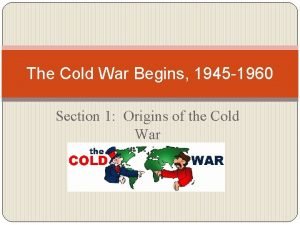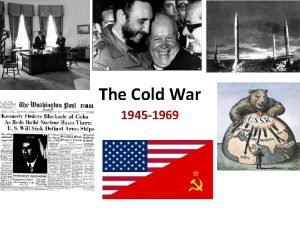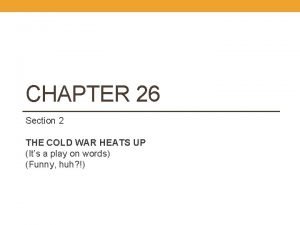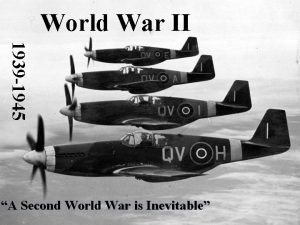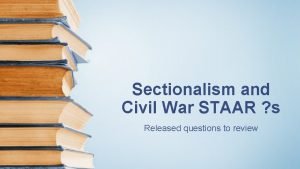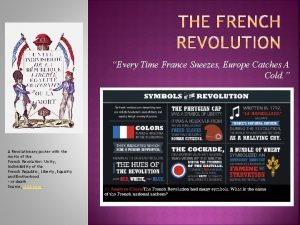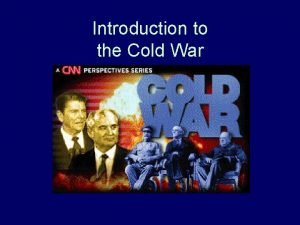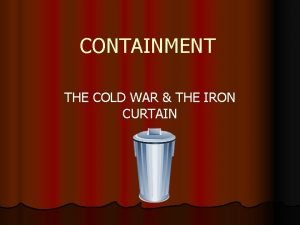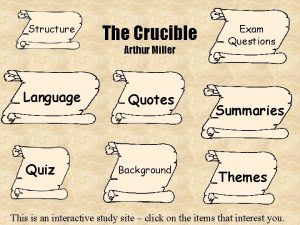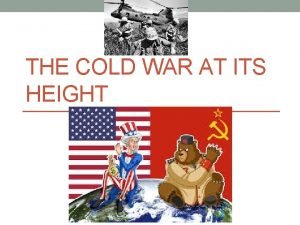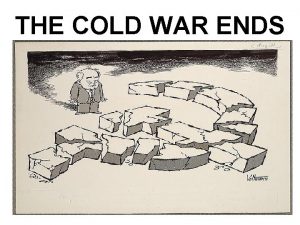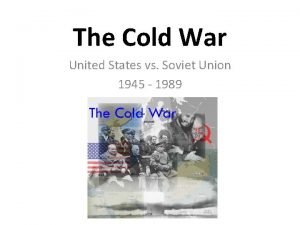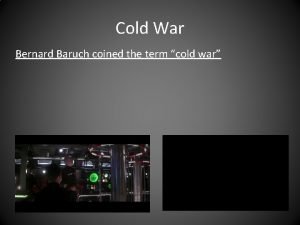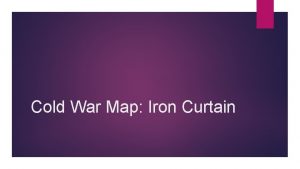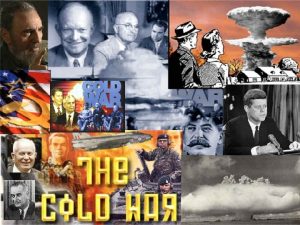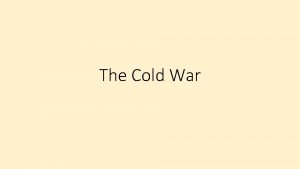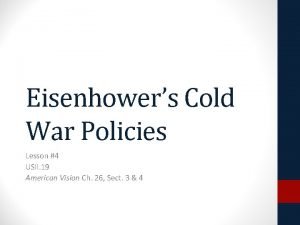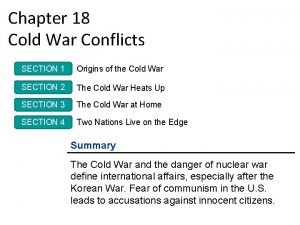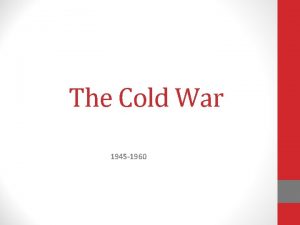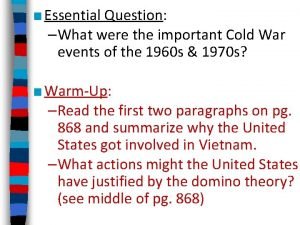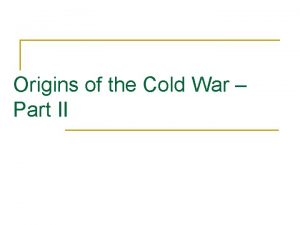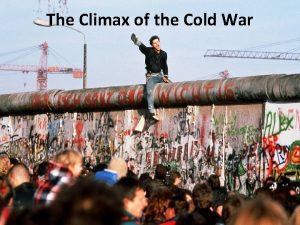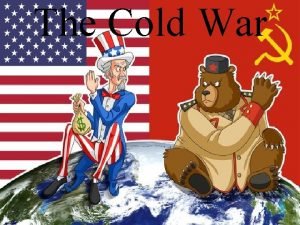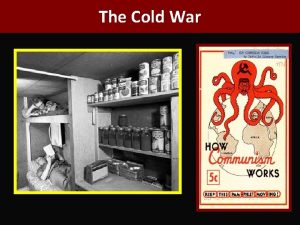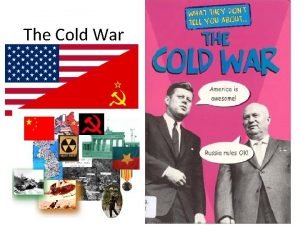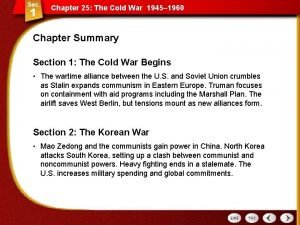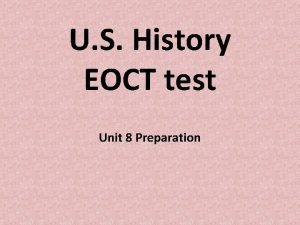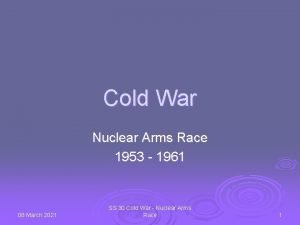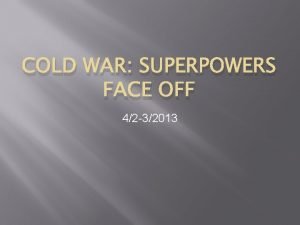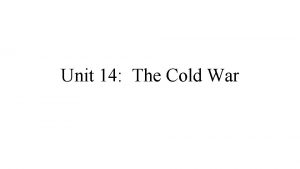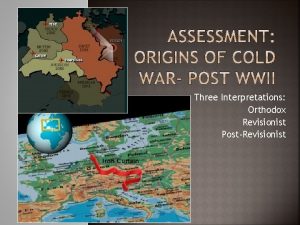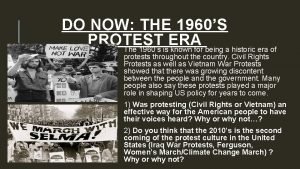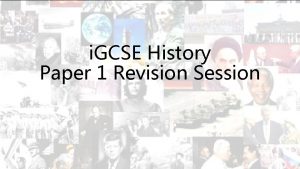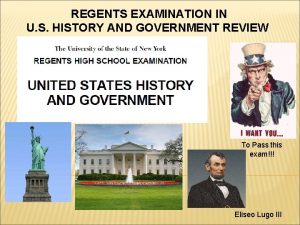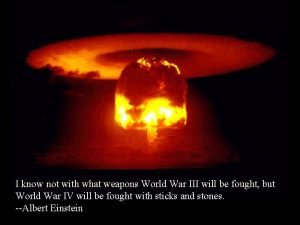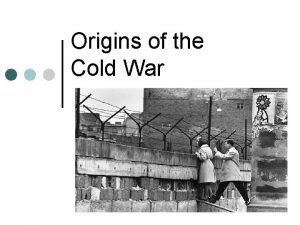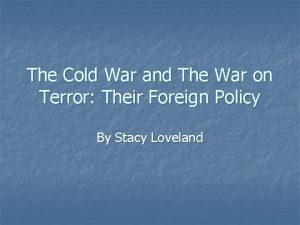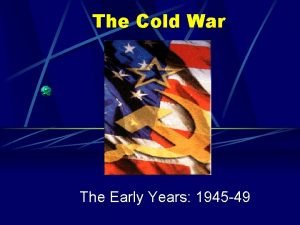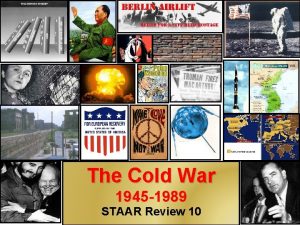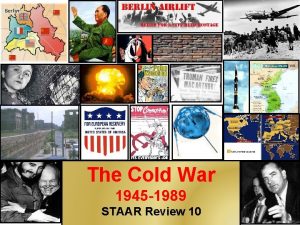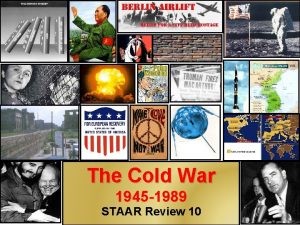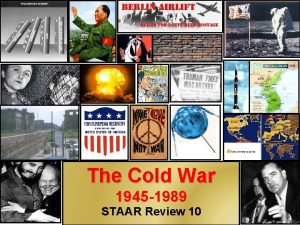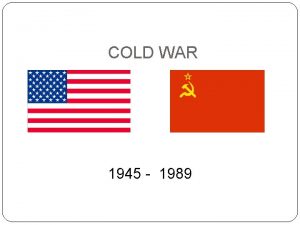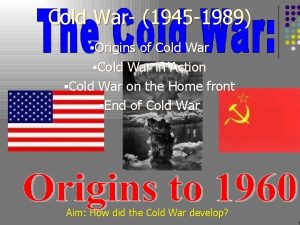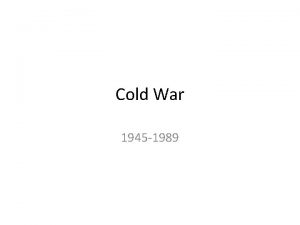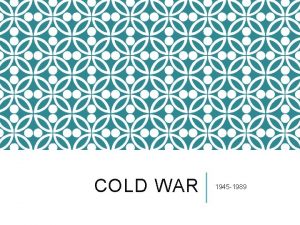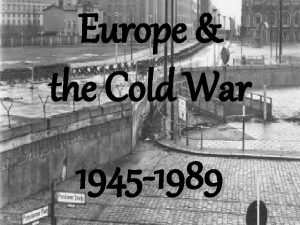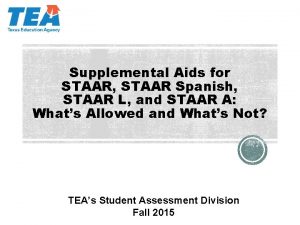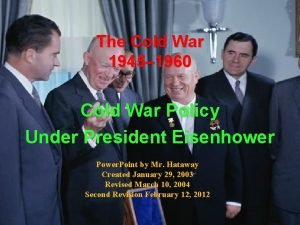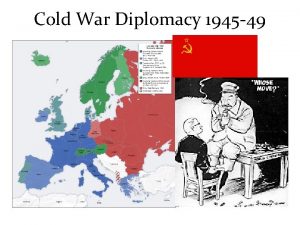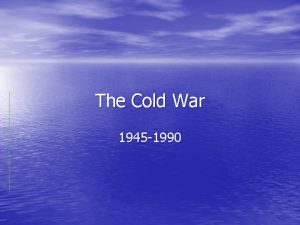The Cold War in Europe 1945 1989 STAAR













































- Slides: 45

The Cold War in Europe 1945 – 1989 STAAR Review 28

TEKS – The Cold War • • US. 2 (D) explain the significance of the following years as turning points: 1957 (Sputnik launch ignites U. S. -Soviet space race US. 8 (A) describe U. S. responses to Soviet aggression after World War II, including the Truman Doctrine, the Marshall Plan, the North Atlantic Treaty Organization, the Berlin airlift, and John F. Kennedy's role in the Cuban Missile Crisis; US. 8 (B) describe how Cold War tensions were intensified by the arms race, the space race, Mc. Carthyism, and the House Un-American Activities Committee (HUAC), the findings of which were confirmed by the Venona Papers; US. 8 (C) explain reasons and outcomes for U. S. involvement in the Korean War and its relationship to the containment policy; US. 8 (D) explain reasons and outcomes for U. S. involvement in foreign countries and their relationship to the Domino Theory, including the Vietnam War; US. 11 (A) describe U. S. involvement in world affairs, end of the Cold War, US. 17 (B) identify the causes of prosperity in the 1950 s, including the Baby Boom and the impact of the GI Bill (Servicemen's Readjustment Act of 1944), and the effects of prosperity in the 1950 s such as increased consumption and the growth of agriculture and business; US. 17 (C) describe the economic impact of defense spending on the business cycle and education priorities from 1945 to the 1990 s;

The Cold War • Although the U. S. A. and the Soviet Union were allies during World War II, these two Superpowers soon became rivals during the Cold War. • It was called a ‘Cold War’ because they never confronted each other directly in open warfare, that was because of the large number of nuclear weapons each side had pointed at the other. • They did engage in a war of words, threats, spying and one-upsmanship that led to frequent conflicts involving other nations on every continent.

Spy vs. Spy

The Roots of the Cold War • The USA and the USSR were allies during WW II, but that would soon change. • The roots of the Cold War lay in the competing ideological systems between the U. S. A. and the Soviet Union. • The United States wanted to spread its system of Democracy (the people rule) and free enterprise. • The Soviet Union (USSR or Russia) wanted to see nations adopt Communism (the government rules).

Democracy v. Communism

Capitalism v. Communism

Joseph Stalin • Joseph Stalin, the leader of the Soviet Union, was supposed to create a classless society that helped all workers, instead he established a brutal dictatorship with him having absolute control. • Anyone Stalin considered to be against him, with or without evidence, could be executed, imprisoned or sent to a gulag (forced labor camp) in Siberia.

The Yalta & Potsdam Conferences • In 1945 as the end of the war neared, the Big Three of Roosevelt, Churchill, and Stalin met in Yalta. • They agreed on: – formation of the United Nations. – a plan on how Germany would be divided up at the end of the war. – the nations they had liberated would have free elections. – Stalin even agreed to let Poland have free elections, ya right! • Later when they met at Potsdam the Big Three disagreed.

The Cold War Begins • After World War II, the Soviets saw a growing threat from the capitalist governments in the West. • To insure a buffer zone between the West and the East, Stalin set up communist governments in these ‘satellite nations’ he now controlled. • The Soviets occupied these nations – prevented free elections, – seized industrial properties and – controlled all parts of the lives of the people of the USSR and eastern Europe. • Churchill said an ‘Iron Curtain’ has fallen over Eastern Europe, cutting it off from the freedoms of the West.


The Truman Doctrine • When Communist rebels threatened to take Greece and Stalin threatened Turkey, Pres. Truman decided to offer these two nations military aid. • Truman did not want to make the same mistake Britain and France made in trying to appease Hitler by giving into their demands. • Truman promised to support any country fighting Communism. • Truman had street credibility! “I believe it must be the policy of the U. S. to support free peoples who are resisting attempts by armed minorities or by outside pressures. ”

The Marshall Plan, 1948 • After World War II, most of Europe was in shambles and many faced famine. • Entire cities were destroyed & farm production non-existent. • Pres. Truman believed people who were desperate might be attracted to Communism. • Secretary of State George Marshall proposed a plan to aid these war-torn nations of Europe to keep them democratic.

The Marshall Plan, 1948 • George Marshall believed that aid would create strong European allies and trading partners for the U. S. A. . • Unlike WW I, where the enemy was treated severely, this plan also included helping rebuild Germany and Italy. • The Marshall Plan was successful in rebuilding Europe and also in benefitting the American economy.

The Division of Germany • At the end of WW II, Germany was divided into an eastern bloc and a western bloc. • The Soviets controlled the eastern bloc, East Germany. • The USA, Britain, & France controlled the western bloc aka West Germany. • The city of Berlin was located entirely within the country of East Germany. • Berlin itself was divided into a West Berlin and an East Berlin The ‘iron curtain’ separated east from west Communism from Democracy

Berlin: a Divided City • Although, in the beginning there was no actual wall separating the two sides, Berlin was a divided city. • In the democratic, western half the people lived good, had many choices, and enjoyed life. • In the communist eastern half, life was not as good, the choices in all parts of their lives was limited by the government. • As a result of the huge differences between the two halves of the city, the people living in East Berlin started moving to West Berlin. • The Russians became concerned that too many people were leaving the east for the west and they aimed to stop it!

Berlin: a Divided City This map shows how Germany was divided as a country. This map shows how Berlin was divided as a city. This small white area shows that the city of Berlin is located inside of East Germany.

The Berlin Wall • In 1961, the Soviets starting building what would become known as the Berlin Wall. • The Berlin Wall was not designed to keep West Berliners out, but to keep the East Berliners in! East Berlin West Berlin • Those who tried to escape from the east to the west were put in prison or shot! • Berlin Wall became physical symbol of the iron curtain and the separation of democracy from communism.

Escape From East Berlin

Scenes of the Berlin Wall An unsuccessful escape attempt On the – No Man’s on East Berlin West left Berliners look. Land across the wall atside the guards. Memorials East. Germans killedthe attempting On the rightto –East West Berliners graffiti wall to escape to the West. Even the East German guards want out! West Berliners theare wall to sneak Sign warninglook youacross that you leaving free a peek at relatives in the east. West Germany to the trapped communist East Germany

The Berlin Blockade & the Berlin Airlift • Berlin is located entirely within communist East Germany. • In 1948 the Russians attempted to limit access to our sector of the city. • The U. S had been trucking in all needed supplies to West Berlin before this ‘Berlin Blockade’ by the Russians. • The U. S. responded to this blockade with the ‘Berlin Airlift’. • The U. S. flew tons of food, fuel, and other materials into West Berlin.

N. A. T. O. - North Atlantic Treaty Organization • In response to the Soviets blockade of Berlin, the U. S. A. and other non-communist nations that surrounded the North Atlantic Ocean, formed a military alliance called NATO. • NATO was based on the concept of collective security, where each NATO member pledged to defend other NATO nations from attack. • The Soviet Union responded by creating the Warsaw Pact with its eastern allies and satellite nations.

Friction Behind the Iron Curtain • Although, America loudly condemned the Soviets aggressive behaviors after World War II, we never directly intervened behind the Iron Curtain. • The U. S. didn’t directly interfere when the Soviets: – Suppressed an anti-communist revolution in Hungary (1956). – Built the Berlin Wall (1961) – Invaded Czechoslovakia (1968)

Containment in Asia • America believed the policy of containment was working & stopping the spread of Communism in Europe. • Then in 1949, China the world’s most populous nation became communist. • Communist China led by Mao Zedong, and helped by the Soviets, overthrew the Nationalist government. • Pres. Truman refused to recognize Communist China and prevented Red China from entering the United Nations.

The Cold War in Asia 1950 -1954 STAAR Review 28


The Korean War, 1950 -1953 • Korea, a former colony of Japan, was divided into two zones after World War II. • North Korea became a communist nation supported by China and the U. S. S. R. . • South Korea became a democratic nation supported by the U. S. A. . • The dividing line was the 38 th Parallel line.

The Korean War • 1950, North Korea invaded the South. • These aggressive actions reminded Truman of the Nazi during WW II. • Pres. Truman sent U. S. troops into South Korea to resist the invasion. • The U. S. was able to pass a resolution in the United Nations to send U. N. troops (mostly Americans) to South Korea. • Korean War became the first war to use an international peace keeping force (United Nations) to halt an aggression.

The Truman-Mac. Arthur Controversy • Pres. Truman sent General Douglas Mac. Arthur to command U. S. forces. • Mac. Arthur landed at Inchon, surprising the North and advanced northward to the Yalu River on China’s border with North Korea. • The Chinese became alarmed and sent large numbers of troops to aide the North Koreans. • Mac. Arthur wanted to liberate China from Communist control by invading China, even if it took the bomb!

The Truman-Mac. Arthur Controversy • Pres. Truman disagreed with Mac. Arthur over the issue of invading China and the use of the bomb. • Gen. Mac. Arthur made the mistake of publically criticizing Pres. Truman. • Pres. Truman relieved Mac. Arthur of his command believing it was necessary to keep civilian control over the military.

End of the Korean War • 1952, Dwight Eisenhower is elected President of U. S. A. . (WW II war hero) • “Ike” was popular and won on the campaign promise of ending the war. • 1953, the U. S. and North Korea signed an armistice ending hostilities. • The agreement called for a DMZ, (demilitarized zone – no weapons) as a buffer between the two Koreas. • The result of the war was that the border between the two, remained the same as before the war began.

STAAR Practice Questions 1 The political cartoon shows Soviet leader Khrushchev pulling down the Iron Curtain. What is this Iron Curtain blocking out? A. Communist ideas of East Germany. B. Democratic ideals of the West. C. Preventing American spies from gathering information. D. Trade between the United States and China.

STAAR Practice 1 Using the image, in 1961 the Soviet Union began building the Berlin Wall. What was the purpose of this wall? • • To provide employment opportunities for West Berliners. To stop East Berliners from escaping into the democratic west. To limit immigration into the communist city of East Berlin. To prevent attacks by the East German military.

STAAR Practice 4 Using the quote, The main goal of the ___ was to stop the spread of Communism and help free nations of the world resist its influences. • • Truman Doctrine Iron Curtain Satellite Nations Marshall Plan “I believe it must be the policy of the U. S. to support free peoples who are resisting attempts by armed minorities or by outside pressures. ”

STAAR Practice 9 Match the post-war super power with its best description. Soviet Union United States

STAAR Practice 10 Winston Churchill gave a speech in which he stated that “an iron curtain had fallen over Europe” which of the following best describes the intent of this quote? • Nations of Europe had become world leaders in the production of steel. • It was an imaginary line that separated communist countries from free democratic nations in Europe. • England other nations of Europe dominated the political and economic system of the Soviet Union. • It describes the Russians ability to build railroads

STAAR Practice 13 Use the map of the Korean peninsula. Due to its location bordering China, what political system did North Korea support? • • Democratic Free Enterprise Monopolistic Communist

STAAR Practice Immediately after World War II, the relationship between USA & USSR became strained because…. • The United States joined with China in standing up to the Soviets. • The Soviets blockaded the USA from entering East Berlin • Soviets placed nuclear weapons in Canada. • Each nation believed the other was a threat to their security and way of life.

STAAR Practice What geographic fact explains why the Berlin Airlift was necessary to defeat the Soviet blockade? • • Berlin is located on the Baltic Sea. Berlin was to close to Cuba. Berlin was isolated by mountains. Berlin was located in the center of East Germany

STAAR Practice Immediately after World War II, the relationship between USA & USSR became strained because of mistrust between the two super powers. This time period became know as …. • • The Marshall Plan The Great Depression The Roaring 50 s The Cold War

STAAR Practice The physical barrier between free democratic city of West Berlin and the communist dominated East Berlin? • • Iron Curtain Berlin Airlift Satellite Nations Berlin Wall

STAAR Practice Which of the following does not describe the post-war environment of the United States after World War II ? • • Significant increase in number of children born called the Baby Boom. Development of suburban housing areas like Levittown's. Increased feelings of trust and cooperation between USA and USSR. Support for any nations standing up to Communism.

STAAR Practice When an armistice was signed ending the Korean War…. • North and South Korea were still divided along the 38 th parallel. • South Korean established a communist government • China exercised its control over the entire Korean peninsula. • Russians sent supplies and money to gain South Koreas’ support

STAAR Practice Which term refers to the Eastern European countries that were dominated by the Soviet Union? • NATO • Warsaw Pact • Satellite Nations • Iron Curtain

TEKS • • • US. 2 (D) explain the significance of the following years as turning points: 1898 (Spanish-American War), 1914 -1918 (World War I), 1929 (the Great Depression begins), 1939 -1945 (World War II), 1957 (Sputnik launch ignites U. S. -Soviet space race), 1968 -1969 (Martin Luther King Jr. assassination and U. S. lands on the moon), 1991 (Cold War ends), 2001 (terrorist attacks on World Trade Center and the Pentagon), and 2008 (election of first black president, Barack Obama). US. 8 (B) describe how Cold War tensions were intensified by the arms race, the space race, Mc. Carthyism, and the House Un-American Activities Committee (HUAC), the findings of which were confirmed by the Venona Papers; US. 8 (C) explain reasons and outcomes for U. S. involvement in the Korean War and its relationship to the containment policy; US. 17 (B) identify the causes of prosperity in the 1950 s, including the Baby Boom and the impact of the GI Bill (Servicemen's Readjustment Act of 1944), and the effects of prosperity in the 1950 s such as increased consumption and the growth of agriculture and business; US. 17 (C) describe the economic impact of defense spending on the business cycle and education priorities from 1945 to the 1990 s; US. 27 (A) explain the effects of scientific discoveries and technological innovations such as electric power, telephone and satellite communications, petroleum-based products, steel production, and computers on the economic development of the United States;
 Welcome 1 unit 10 lesson 1
Welcome 1 unit 10 lesson 1 The cold war begins 1945-1960
The cold war begins 1945-1960 The cold war heats up: 1945 - 1969
The cold war heats up: 1945 - 1969 The cold war heats up: 1945 - 1969
The cold war heats up: 1945 - 1969 Proxy wars cold war
Proxy wars cold war 1945 world war ii
1945 world war ii 1945 world war
1945 world war Civil war staar questions
Civil war staar questions When france sneezes europe catches a cold
When france sneezes europe catches a cold Who marked when france sneezes europe catches a cold
Who marked when france sneezes europe catches a cold Origin of cold war
Origin of cold war Iron curtain containment
Iron curtain containment Hysteria in the crucible
Hysteria in the crucible Cold war at its height
Cold war at its height Peep under the iron curtain
Peep under the iron curtain Cold war
Cold war Soviet
Soviet Bernard baruch cold war
Bernard baruch cold war George orwell cold war
George orwell cold war Cold war map iron curtain
Cold war map iron curtain Comunist map
Comunist map Was the cold war capitalism vs communism
Was the cold war capitalism vs communism Lesson 4 eisenhowers cold war policies
Lesson 4 eisenhowers cold war policies Origins of the cold war chapter 18 section 1
Origins of the cold war chapter 18 section 1 Summary on the cold war
Summary on the cold war Brinkmanship cold war
Brinkmanship cold war Origins of the cold war
Origins of the cold war When was the climax of the cold war
When was the climax of the cold war Cold war
Cold war Characteristics of the cold war
Characteristics of the cold war The cold war heats up lesson 2 answers
The cold war heats up lesson 2 answers Iron curtain cold war
Iron curtain cold war Cold war summary
Cold war summary Cold war
Cold war Cold war
Cold war Cold war
Cold war The cold war vocabulary
The cold war vocabulary Postrevisionist
Postrevisionist Doves cold war
Doves cold war Operation rolling thunder cold war
Operation rolling thunder cold war Watergate cold war
Watergate cold war Weapons of the cold war diagram
Weapons of the cold war diagram Marshall plan cold war definition
Marshall plan cold war definition The cold war
The cold war Cold war who was involved
Cold war who was involved Marshall plan cold war
Marshall plan cold war

